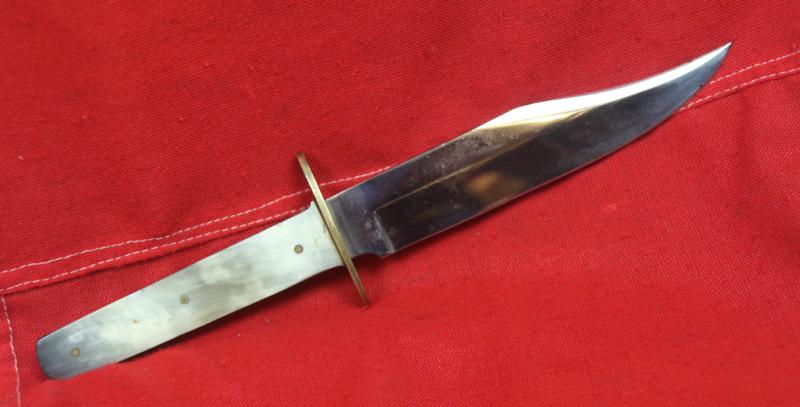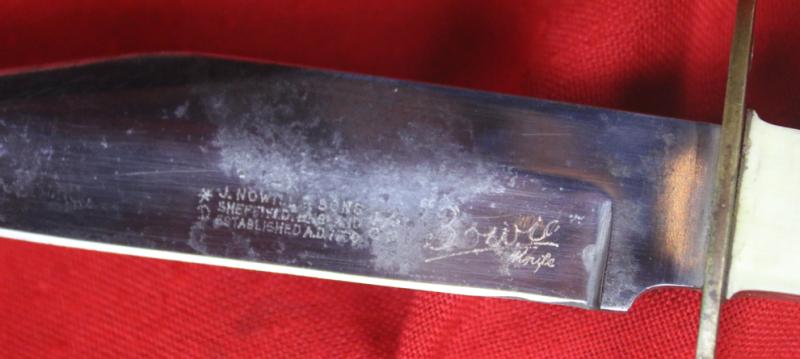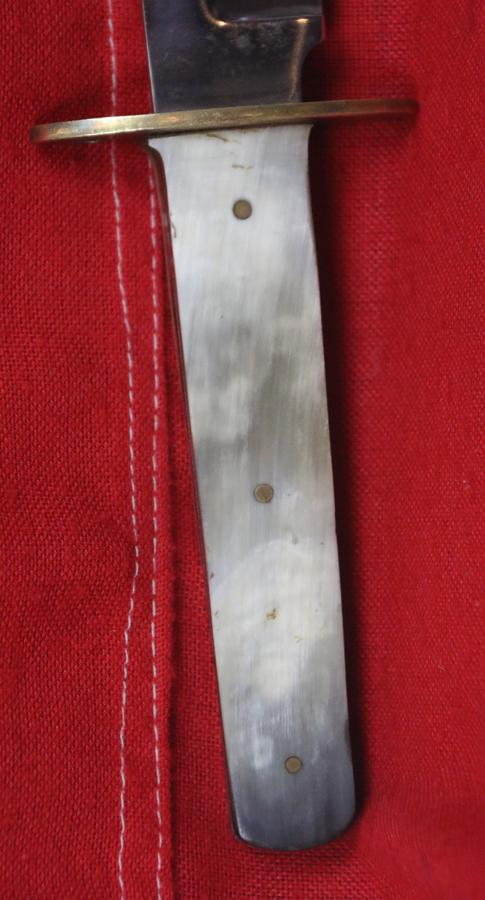A Good J.Nowill & Son Bowie Knife With White Buffalo Horn Grip Plates
Good blade, brass crossguard and triple rivet grip plates in carved white buffalo horn.
The blade is maker etched and retains some pitting to one side. The term "Bowie knife" appeared in advertising by 1835, about 8 years after the Bowie's famous sandbar knife brawl, while James Bowie was still alive. The first knife, with which Bowie became famous, allegedly was designed by Jim Bowie's brother Rezin in Avoyelles Parish, Louisiana and smithed by blacksmith Jesse Clift out of an old file. Period court documents indicate that Rezin Bowie and Clifft were well acquainted with one another. Rezin's granddaughter claimed in an 1885 letter to Louisiana State University that she personally witnessed Clift make the knife for her grandfather.
This knife became famous as the knife used by Bowie at the Sandbar Fight, a famous 1827 duel between Bowie and several men including a Major Norris Wright of Alexandria, Louisiana. The fight took place on a sandbar in the Mississippi River across from Natchez, Mississippi, and is the only documented fight in which Bowie was known to have employed his Bowie knife design. In this battle Bowie was stabbed, shot, and beaten half to death but managed to win the fight using the large knife.
From context, "Bowie knife" needed no description then, but the spelling was variable. Among the first mentions was a plan to combine a Bowie knife and pistol. Cutlers were shipping sheath knives from Sheffield England by the early 1830s. By 1838 a writer in a Baltimore newspaper (posted from New Orleans) suggested that every reader had seen a Bowie knife.
The Bowie knife found its greatest popularity in the Old Southwest of the mid-19th century, where several knife fighting schools were established to teach students the art of fighting with the Bowie knife pattern.
Bowie knives had a role in the American conflicts of the nineteenth century. They are historically mentioned in the independence of Texas, in the Mexican War, the California gold rush, the civil strife in Kansas, the Civil War and later conflicts with the American Indians. John Brown (the abolitionist) carried a Bowie (which was taken by J. E. B. Stuart). John Wilkes Booth (assassin of Abraham Lincoln) dropped a large Bowie knife as he escaped. "Buffalo Bill" Cody reportedly scalped a sub-chief in 1876 in revenge for Custer (the Battle of War bonnet Creek).
The popularity of the Bowie knife declined late in the nineteenth century. Large calibre reliable revolvers were available by the mid-1870s, reducing a knife advantage. The frontier rapidly vanished, reducing the number of hunters and trappers. Large knives had limited utility, so Bowies shrunk. This family company was first based in Meadow Street, but later moved to Scotland Street around 1840. It was in 1842 that the first of John Nowill’s sons, William, joined the business after finishing his apprenticeship. His maker’s marks of ‘D*’ and ‘KROSSKEYS’ remain the marks of the company to this day. At the Great Exhibition in 1851 the company won a Prize Medal for their selection knives for ‘the Levant trade’. The Levant is an historical term for the near East, covering modern day countries such as Syria, Israel, Cyprus, Turkey, Palestine, Jordan and Lebanon. The company retained strong trade links with this area, having agents in Turkey, Egypt and Greece. In 1851 there were fifty men and boys working for John Nowill & Son, however, steady expansion meant that by 1881 they employed one hundred men, ten boys and fifteen women. In 1881 they also registered their first silver mark, which showed they were moving into making valuable silver and electro plate items. They registered a second silver mark in 1901. Despite surviving the difficult interwar years, the company was sold to F.E. & J.R. Hopkinson in 1947, and later acquired by J. Adams Ltd.
Blade 6" long overall 10.25 inches, no scabbard
Code: 24502
285.00 GBP





